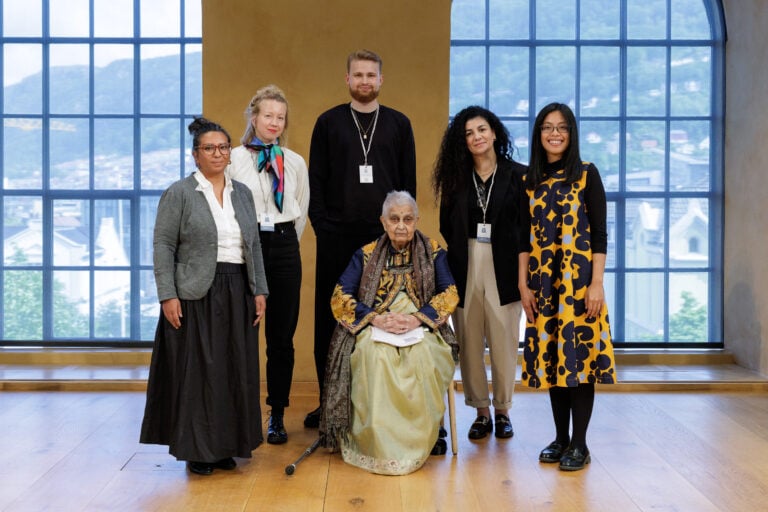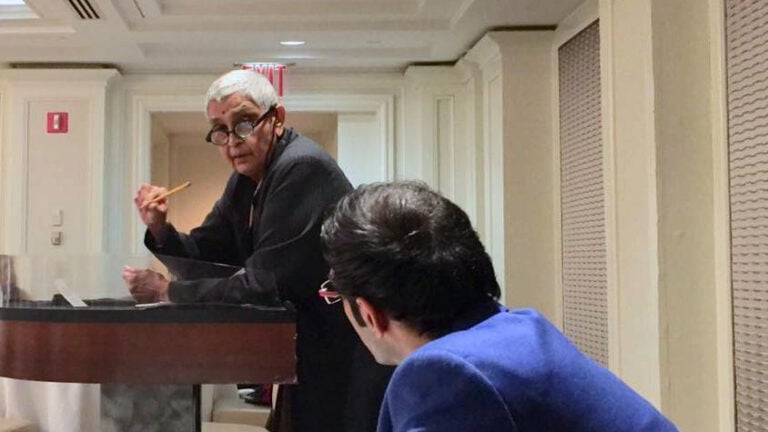Sabina Ivenäs’ presentation from the Holberg Masterclass with Gayatri Chakravorty Spivak on ‘The Practice of Learning’.
All disciplines produce knowledge and the students learn to know. The humanities – literature and philosophy – teach the practice of learning. In knowing, you know an object.
Introduction
On 4 June 2025, Five PhD candidates in the Nordic countries were invited to participate in a Masterclass with Holberg Laureate Gayatri Chakravorty Spivak on ‘The Practice of Learning’. Each of the participants gave a short presentation on the topic based on their research. The following text is a transcript from the presentation Sabina Ivenäs gave at the event.
Representation and Responsibility: A Perspective on the Practice of Learning
Thank you. It’s a pleasure being here. Thank you for inviting me to take part of this important and interesting conversation. My talk is essay like and with perhaps a poetic touch, I will reflect on postmigrant poetry in the Nordic countries and my research position.[1] I will, in some sense, enter the more personalized field of identity, in an attempt to follow Professor’s Spivak’s proposal of “inhabit the ‘human’ in the humanities’.[2] In my talk I will use the word poem, but in doing so I’m not referring to a specific poem but to the poem as such.
The world is broken, paraphrasing Professor Spivak.[3] Is there is hope? The human condition is hidden in the poem. Where are we going from here? Swedish contemporary poet Athena Farrokhzad might call this poem ”Poetry in the Time of Doom”.[4] It’s a dystopian tale, this poem. It’s about refugees, hate and violence. But also love friends, laughter and families. What should we call this experience? How should we refer to this poem?
Globalization is since many years a fact.[5] Since then, we have used many words in trying to grasp the many different questions of migration. Still, in the relation to the this discussion within academia, many poets of various backgrounds have to ask: am I part of this definition?[6] And the literary scholar must answer: I don’t know yet.[7]
In my thesis I use the term postmigration and the postmigrant condition. What is beyond migration, this terminology asks. It can be used in many ways and I have chosen the following definition from Danish Mortiz Schramm m.fl. Reframing Migration, Diversity and the Arts-The Postmigrant Condition (ed. Mortiz Schramm, 2019): 1) to explain complex experiences of being second or third generation immigrants in the Nordic countries, but also to include voices of transnational adoptees- (a category I myself belong to, born in India, adopted and raised in Sweden).[8] 2) To use postmigration as a theoretical lens and 3) To understand the Nordic countries a whole, as part of a postmigrant condition, which everyone, migration background or not, is part of.[9] In my thesis, this broad definition is under investigation.[10] Is it useful for this time? How can we make use of it in the classroom?[11] What can we learn from it, poetry asks. What can we learn from poetry, the literary scholar asks.
In my project I see poetry as a source of knowledge.[12] We should learn from poetry.[13] Still, as I view my material which include Nordic poets such as Danish Maja Lee Langvad, Eva Tind; Swedish Athena Farrokhzad and Mara Lee to (Brynjulf Tjønn) name a few, I can say that it is not an easy read, and although necessary, learning from below in Professor Spivak’s words, is proved difficult when it’s depicted through whatever fragments remain, in a postmigration experience. It is not a confused poem, but it creates a confused reader. It is a difficult poem, challenging the ways of readings.This postproduction of poetry as Danish poet and scholar Martin Glaz Serup prefers calling it,[14] is on the one hand a well-trained machine using all the pieces of from the historical archive. On the other hand, it is a work of poetry that strives to capture the harsh realities in the wake of fragmented experiences such as war, concentration camps and exile are leaving us with.[15] What is this poem? I ask. It’s conceptual poetry, not embarrassed to borrow phrases, texts or poems from others. Not ashamed of drawing on other peoples’ experiences. Is this love or hate for the other, I wonder. Is it a self-reflexive longing for the otherness within,[16] I ask. What is this line of questions, some of you might wonder. And I will answer: It’s the question of defining the exile experience within comparative literature: to whom might it belong? Reframed in a more traditional set of questions: Is this exile literature in terms of being written by an exile poet or is it exile literature as it addresses exile as a theme?[17]
I frequently get questions if my project is about representation. And to that I say: yes and no. Because how do we handle the difficult task of bridging these questions into academia? In my research I couldn’t possibly say that I represent someone else. However, I’m standing here today, in this beautiful, safe and proud moment, and bring light to poets with different relationship to migration backgrounds, who otherwise would be in the margins.
When I presented part of my research at a conference, I got approached by a professor in the audience. A white older man, if that’s relevant. He said, “You can help us understand this poetry, you can translate this for us”.[18] But as translation here is impossible,[19] I cannot do that. But the situation raises thought-provoking questions about subalternity;[20] although not in the sense that the poets I’m studying would be subaltern, in this context they are marginalized. It’s about the didactic question ”What do we read” and the question of within which spaces, curriculums, [21] this poetry is allowed. It also raises the question of who has the possibility to speak but more importantly, who has the ability and responsibility to listen.[22]
What can we learn applying a postmigrant perspective?[23] What can poetry teach us about postmigration? For scholars in comparative literature, this might be two different questions. But for the racialized poet, it might be the same. Then who should we listen to, if we want, in line with Professor Spivak’s suggestion “to learning to learn from below?”[24] It becomes an ethical question.[25] In other words, we need to take care of these questions. Not try to make them our own but allow us to be part of them.[26]
The world is upon us while the classroom is something very real and concrete. Yet, as professor Spivak reminds us in “Crimes of Identity”, the classroom is still a dream for some. The poem is, or at least should be, a safe room for readers. It’s a place for hope and dreams. And then, as readers, perhaps we can begin to wonder, what we don’t yet understand.
Thank you.
Notes
[1] As Spivak advocates in for instance Death of a Discipline (2003), every scholar within the humanites should recongize the intersectional dynamics within the humanites. By demonstrating an awareness and reflecting on my research position, I realize that the dynamics of intersectionality opens up for listening. Here i find support in Spivak statement in Death of a Discipline (2003) that it is not about politizing, because it’s already politizied (qoute correctly).
[2] Gayatri, Spivak, ”Crimes of Identity”, in Juliet Mitchell and the Lateral Axis: Twenty-First-Century Psychoanalysis and Feminism, (ed. Robbie Duschinsky and Susan Walker), Palgrave Mcmillan US, pp. 207-227.
[3] Gayatri C. Spivak, ”Teaching for a Broken World», in ANGLICA-An International Journal of English Studies, 2024, vol. 33, no 3, p. 17.
[4] ”Poetry in Times of Doom” is a doctoral 5 credit course, given by poet Athena Farrokhzad in her role as a guest professor at at Linköping’s University, Sweden, during spring 2025.
[5] It’s a fact that we refer it to globalization, but as Spivak states in ” Willing Suspsion of Disbelief, Here Now” (2016), global citizenship is fiction, see p. 310.
[6] I’m here referring to an ongoing discussion of theoretical terms used in comparative literature in the Nordic countries in relation to what’s been called ”migration literature”. SeeMaimouna Jagne Soreau, Postinvandringslitteratur i Norden. Den litterära gestaltningen av icke-vita födda och uppvuxna i Norden, Helsingfors universitet, 2021.
[7] Based on this discussion, I think there are some troubles in how this terminology, although necessary, generates difficult and sensitive questions about how to view and label/name, categorize the other. For further discussion see Astrid Trotzig, ”Makten över prefixen” i Orientalism på svenska, s. 104–127, 2005, Maimouna Jagne Soreau, Postinvandringslitteratur i Norden. Den litterära gestaltningen av icke-vita födda och uppvuxna i Norden, Helsingfors universitet, 2021, p. 16 and Niclas Johansson, ”Kulturell och narrativ identitet Sami Saids Väldigt sällan fin som migrationslitteratur”, Samlaren, årg. 145, 2024, s. 164-200.
[8] This relates to the question of “identity”, which in Spivak’s words can be explain in the following words, as a point she made at Cambridge 2014: “[one, that] having a certain kind of ´’identity’ allows groups with preferred ‘identities’ to initiate and sustain policy that, although legal, may be considered as ‘criminal’ by natural law, if it were humane in the colloquial sense’, in Spivak, “Crimes of Identity”, p. 207.
[9] Mortiz Schramm m.fl. Reframing Migration, Diversity and the Arts-The Postmigrant Condition, New York, 2019, and earlier in in Petersen & Schramm, ”Postmigration. Mod et nyt kritisk perspektiv på migration og kultur” i Kulturkritik, nr 122, 2016. s, 183. Indeed, there is a lot to unpack in this definition, which is also part of what my dissertation is about. These different aspects of the definition can of course on the one hand be used more specifically, which previously research have done, one the other hand it can be seen as different levels of knowledge (rephrase), that when put together and read in relation to each other, can give new insights about this particular and very complex and quite new experience in Nordic contemporary poetry.
[10] See Maimouna Jagne Soreau, 2021, p. 13 and 15.
[11] This too is a problematic question. I want to make clear that I here by no means mean that we can and should learn about ”the other” or in this case the ”immigrant”. I want to avoid the “native informant”, cf. Spivak, A Critique of Postcolonial Reason, Toward a History of the Vanishing Present, 1999.
[12] I share this view with some of the poets I include in my material, like Athena Farrokhzad and Burcu Sahin who both been in invited to Linköping’s university, in different capacities, to practice the borders between poetry and knowledge as in humanities, cf. Spivak, 2024, p. 13.
[13] See Spivak’s words “Let the literature teach!”, in Spivak 2003.
[14] Martin Glaz Serup, Relationel poesi, 2013, s. 53., cf. Serup, 2015, s. 24–27.
[15] Martin Glaz Serups avhandling Kulturel erindring og konceptuel vidnesbyrdlitteratur, Köpenhamns universitet, 2015.
[16] This is a blink to Minha Trinth, a feminist theorist that Spivak gladly put her books side by side with, Spivak 1999, p. xi.
[17] Cf. Anders Olsson. Ordens Asyl, 2011 and Daniel Pedersen, Exillitteratur i Sverige 1969-2019, 2022 with reference to Said, E. W. “Reflections on Exile.” I Edward W. Said, Reflections on Exile and Other Essays. Cambridge: Harvard University Press, 2000, s. 173.
[18] cf. Stefan Jonsson on “transnational and transracial literacy” in ” Världens centrum”, p. 469.
[19] cf. Gayatri C. Spivak, ”Crossing Boarders”, in Death of a Discipline, 2003.
[20] Gayatri C. Spivak, “Can the Subaltern Speak?”, and revisited. Spivak, Gayatri C. 1999. Can the subaltern speak? Section from Chapter 3 “History” in Critique of postcolonial Harvard University Press, pp. 244-311 and Spivak, Gayatri C. 2010. “In response”, in Can the subaltern speak? Reflections on the history of an idea, Rosalind C. Morris (ed.). Columbia University Press, pp. 227-236.
[21] Gayatri C. Spivak, ”Teaching for a Broken World», in ANGLICA-An International Journal of English Studies, 2024, vol. 33, no 3, p. 17.
[22] Gayatri C. Spivak,”Can the Subaltern Speak”, 1999 and “In response”, 2010.
[23] Cf. Gayatri C. Spivak, ”Willing Suspension of Disbelief. Here, Now”, in Constellations of a Contemporary Romanticism, (ed. Jaques Khalip and Forrest Pyle), Fordham University Press, 2016, pp. 315.
[24] Gayatri C. ”Preface to the Twentieh Anniversary Edition” in Death of a Discipline. Twentieth Anniversy Edition, Columbia University Press, p. 7.
[25] Cf. Spivak, ”Willing Suspension of Disbelief. Here, Now”, p. 311.
[26] At least if we want to be open for a learning experience that in Professor Spivak’s words could be a “slow cooking of the soul” Spivak, 2024 (teaching for a broken world), p. 13.
Last edited:
Published:
About the author
Sabina Ivenäs
 Sabina Ivenäs. (Photo: Private.)
Sabina Ivenäs. (Photo: Private.)
Sabina Ivenäs is a PhD candidate in Comparative Literature at the University of Gothenburg. She holds an MA in Language and Culture in Europe. Her current research explores the postmigrant condition in contemporary Swedish and Danish poetry, with particular attention to its didactic dimensions.
My contribution to the Masterclass reflects on the ethical and pedagogical dimensions of teaching and exile through poetry. By using the concept of postmigration and the work of Gayatri Spivak, I want to discuss representation, listening, and the role of poetry for learning. Drawing on my research and teaching, I ask: what can poetry—particularly that emerging from marginalized voices—teach us about the human condition, and what responsibility do we as academics carry when read, name, and engage with it?
Related content

“I Know What You Said and I Also Know What I Heard”: Creole Languages and the Case for a Humanistic Linguistics
Jillian Loise Melchors presentation from the Holberg Masterclass with Gayatri Chakravorty Spivak on 'The Practice of Learning'.

Staging Silence: Subalternity, Imaginative Activism, and the Limits of Historiography
Johannes Sartous presentation from the Holberg Masterclass with Gayatri Spivak on 'The Practice of Learning'.

The Holberg Masterclass with Gayatri Chakravorty Spivak: ‘The Practice of Learning’
All disciplines produce knowledge and the students learn to know. The humanities – literature and philosophy – teach the practice of…

